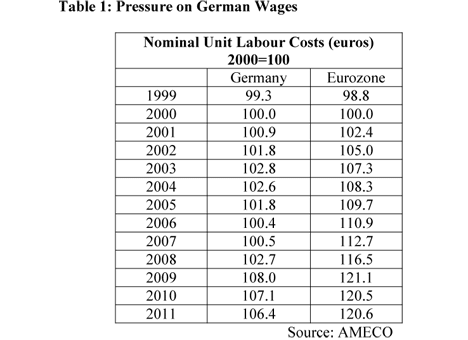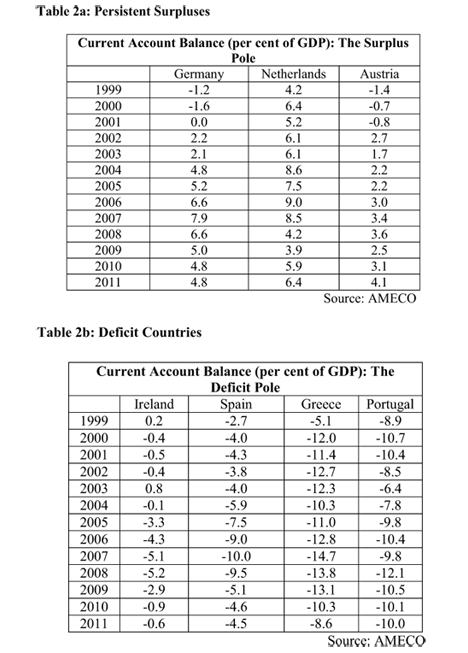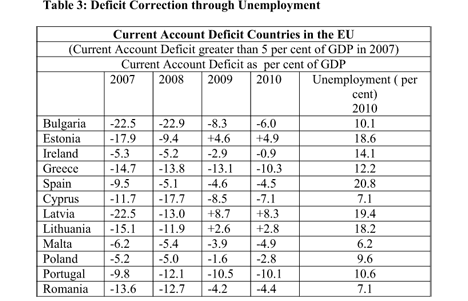Well before the Maastricht Treaty and the introduction to the euro, the economic analysis of monetary unions had reached widely accepted conclusions. The advantages of using one money instead of two or more always have the same character – a reduction in many transactions costs. The importance of these advantages depends then on the actual and potential transactions among the territories in question: where there is little trade between two countries and few financial interactions, there won’t be many benefits from the use of a single currency; if, on the other hand, economic interrelations are many and intense, the gains will be much larger.
What are the costs and problems in moving to a single currency? The key issue concerns monetary policy: what are the costs to a country of giving up its own monetary policy? There are two key policy variables that it loses control of. Firstly, the exchange rate can no longer be altered – that of the monetary union has to be accepted. This means that when a country encounters problems of competitiveness, it can no longer devalue its currency (if the exchange rate was fixed) or allow it to depreciate (in the case of a floating currency). Such exchange rate changes are a very effective and relatively painless way of dealing with competitiveness problems and unsustainable trade deficits. In the recent crises it has been a big advantage for Britain that it was not in the Eurozone and was therefore able to let the pound fall against the euro and other currencies.
Secondly, to join a monetary union is to give up domestic control of interest rates. These are used to influence the costs of financing investment and consumption expenditures and thus the level of expenditure and the consequent levels of economic activity and employment. If the economies in the monetary union as a whole move closely together this may not be a problem – a common monetary policy can be appropriate for them all. On the other hand, if the economies diverge – some tending to overheating and inflation while others are in recession, then the loss of the interest rate instrument could prove to be very costly.
Thus divergence in competitiveness or in the general rate of production and employment across the member economies is a central challenge to monetary unions. How can that challenge be met? Standard theory pointed to two mechanisms, one based on markets, the other on government. Divergent rates of unemployment could be tempered through the market mechanism of out-migration from depressed countries or regions; and if the monetary union had a common public budgetary policy, a government could intervene through raising taxes in the more successful economies to support expenditure in those in difficulty.
Both mechanisms can be found in the United States: if one state has higher unemployment than the others a lot of people will leave; while the working of the federal income tax and social security systems redistributes income to the states with weaker economic performance.
Neither mechanism exists in the Eurozone. There has been some labour migration from central and eastern European members of the EU, but several of them, including Poland, the largest, do not yet use the euro. There has not been much migration among the main countries using the euro since the 1970s. And, since the central budget of the EU is very small, there is no possibility of fiscal transfers.
The Eurozone – with built-in dogma
How then was the monetary union supposed to work, without any way of coping with divergence? There were two views. One, which it is reasonable to associate with the French, relied on further institutional development or “creative imbalance”. Experience with the monetary union would show that it needed a stronger institutional framework, including more centralised taxes and public expenditures. At that point the EU would give rise to the necessary institutions. This view may still prove to be correct in the long run – if the EU cannot strengthen its institutions in response to current crises it will be in deep trouble indeed.
So far, however, the opposite view has prevailed. It is correct to associate this with Germany (both with the Bundesbank, which acted as the model for the ECB in the same city, and with most German political leaders). The Eurozone does not need stronger institutions and can function perfectly well without any fiscal transfers. This view is contrary to both logic and experience, but that does not stop it being received wisdom in the EU and the Eurozone. The dogma is straightforward: market economies are intrinsically stable. If the central bank keeps inflation under control, and member state governments refrain from excessive spending and borrowing (that is, if they observe the rules of the “Stability Pact”), nothing can go wrong in terms of macroeconomic policy. There may be unemployment but that will not reflect interest rates which are too high or budgetary policies which are too restrictive; it can only be the result of labour market “rigidities” – employment regulation, social protection and so on – which must be removed by “structural reforms”. The fact that three decades of such reforms have done nothing to bolster employment (though they have done plenty to undermine wages and conditions and to exacerbate social injustice) only proves that they need to go much further.
Provided, then, that inflation was controlled and the rules of the Stability Pact observed, there would be no need for active macroeconomic policies. It is interesting that these rules were in fact broken continuously, but not by the countries which today face the most acute public sector deficits. Some of these countries, notably Spain and Ireland, were actually star pupils when it came to budgetary rigour – they ran public sector surpluses while Germany, France and other high income countries failed to keep government borrowing within the prescribed limits.
Meanwhile, huge divergences in prices and competitiveness were developing. They were simply ignored by policy-makers at the European Commission, at the European Central Bank and in most of the member states.
Germany – the divergence machine
Since capitalist economies are not in reality self-correcting and self-balancing in the way that orthodox doctrines assert, one could have expected, even under normal conditions, that the economies in the Eurozone would diverge, with some becoming more and others less competitive against each other. However, conditions after the single currency was introduced in 1999 were such as to make for wide and rapid divergence. The strongest economy by far in the Eurozone is that of Germany, and German policy put enormous pressure on the weaker economies in the monetary union. Unemployment was high in Germany, partly because of the general economic slowdown of western economies from the mid-1970s, partly because of the problems of reunification. To absorb this unemployment it would have been possible to stimulate domestic spending either by redistributing income to the most disadvantaged groups or by increasing public spending. Actual policy, driven by doctrines divorced from reality and by the interests of the big multinational groups, concerned only to reduce taxes and wage costs in their German base, was the opposite of this. Public spending was squeezed and welfare benefits in particular were cut. There was a deliberate attempt to create a low wage sector in Germany, in supposed imitation of the United States (no attempt was made to imitate the massive and repeated macroeconomic expansions brought about by monetary and fiscal policies in the US).
The restriction of domestic demand and the squeeze on wage costs within Germany amounted to an enormous export drive – the only growing markets for German goods and services were abroad. This was a strategy of staggering irresponsibility at both the global and the European levels. In the global economy the US trade deficit was becoming increasingly difficult to finance – massive German export pressure could only complicate and retard the task of correcting the deficit. In Europe, many of the weaker economies – including the UK – had competitiveness problems which could only be aggravated by the big and growing German surplus. Those economies in the Eurozone that – unlike the UK – were unable to let their currencies fall in value faced the most intractable problems.

The extent of German pressure on export markets is suggested by Table 1, which shows how wage costs per unit of output developed in Eurozone countries. Unit wage costs depend on productivity growth, which reduces them, and the growth of wages, which increases them. In turn, they are a major factor determining prices and inflation. The broad policy of the Eurozone was to keep inflation just below 2 per cent, and most countries managed to keep wage costs more or less in line with this target. In Germany, on the other hand, there has been a continuous drive to keep wage costs well below what was required, and this was at the expense of lower-paid workers in particular. Wages in Germany grew much slower than labour productivity (this redistributes income from labour to capital), and indeed often grew more slowly than prices, so that real wages were falling in the world’s most successful industrial economy. At one point the German government, concerned to reinforce its already overwhelming competitive advantage, reduced social security contributions and made up for the ensuing loss of tax revenue by increasing VAT. This cut the price of German exports but pushed up the price of imported products: it was equivalent to devaluation – a devaluation from the world’s largest exporter which posted a balance of payments surplus of $300 million, second only to that of China. (The Chinese have a much better justification for their surplus than does Germany; it is quite difficult for the Chinese to expand internal markets rapidly since infrastructure is underdeveloped – it is pointless, to use a simplistic example, to offer refrigerators to households without electricity; meanwhile an export drive keeps employment and incomes rising; no such justification can be advanced for the German surplus, which expresses both a blinkered conception of Germany’s own interests and a contempt for those of other nations.)
Increasing tensions in the Eurozone
A few of Germany’s close neighbours in the Eurozone – such as Austria and the Netherlands – managed to live with this continuous competitive pressure, presumably by working very carefully to make their smaller economies complementary to the large German one. But as Tables 2a and 2b show, imbalances have been widening almost since the start of monetary union in 1999. (The fact that Germany began with a modest current account deficit was a consequence of German unification – for a few years the East German deficit wiped out the West German surplus – but soon export business as usual was resumed.) And no action is being taken even now to rein in Germany’s export pressure on its trading partners. Indeed, the European Commission cheerfully forecasts a widening of the surplus to 7 per cent in 2012.

From the start the “peripheral” countries shown were suffering a trend loss of competitiveness. The German surplus was a major factor in that situation, but there were clearly also serious policy errors in some of the countries concerned. In both Spain and Ireland huge speculative bubbles developed in construction and real estate. Rather than doing anything to counteract speculation, the authorities celebrated the economic success which the bubbles seemed to represent, as incomes rose rapidly and employment grew. Note that, as pointed out above, in neither Ireland nor Spain was there any sign of problems in government spending; on the contrary, both countries had public sector surpluses. In Greece, on the other hand, it seems that there were big problems with the government budget, which existed even before entry into the monetary union.
Nevertheless there were clearly big payments imbalances which were rapidly getting bigger. How could these come about? The simple answer is that they were financed by borrowing.
Financing divergence: The boom
Markets don’t clear; imbalances and disequilibria are ubiquitous; at any given time many households, businesses and countries will be in “unsustainable” positions. This is possible because of the financial system – without it market economies could not exist. In an ideal world it would be clear to everyone how, and how fast, imbalances should be corrected. The financial system would smoothly and gradually enforce the necessary adjustment; an economic unit with a deficit position would find that the longer that deficit lasted and the bigger it grew the higher would be the interest rate demanded and the more “conditionality” would be attached to each refinancing operation. Effectively monitored, households would gradually pay down their debts, businesses would expand, contract or redirect their activities as necessary.
Things aren’t like that. Consider the most elementary situation: someone owes you money but cannot pay on time. Do you refinance them or not? If you’re going to refinance it may be better to do so generously – no point in spoiling the ship for a hap’orth of tar. On the other hand, why throw good money after bad? And if you’re going to foreclose, best to do so right away before all the assets held by your debtor are dissipated. It’s not a decision which allows smooth trade-offs. Which is the right decision? It is not always easy to say – either course of action might succeed; either, or indeed both, might fail.
Nor are such decisions taken independently of each other. They relate not only to the specifics of each loan and investment but to general business conditions: the level of activity and employment, widely shared expectations about the future economic developments, the degree of pessimism or optimism among investors. Thus credit conditions tend to move in the same direction for all borrowers – easy credit tends to be general, but when credit tightens it tends to do so drastically and across the economy as a whole.
The peripheral economies were able to finance wide and increasing current account deficits because, over the first decade of the monetary union, credit conditions were generally easy. This was for two main reasons.
Firstly interest rates around the world were low – there was an abundance of investible funds and monetary policy in the US was very expansionary. Secondly, the EU itself encouraged financial changes which reduced effective supervision over banks and security trading. There was in fact something of a moral panic in the European political class as it drew up its Lisbon Agenda for the first decade of the present century. The recent success of the US economy was both exaggerated and misunderstood. (The relatively higher growth rates that had been achieved in the US were primarily the result of American readiness to adopt expansionary macroeconomic policies – which EU leaderships, for dogmatic reasons, always refuse). Drastic action was proposed for Europe to “catch up” – including an attempt to Americanise European financial systems by promoting big integrated markets for shares and government bonds. There was virtually no concern about the possible implications of this strategy for financial stability.
There was thus a climate of easy credit and investor optimism in which deficit countries in the Eurozone came under no pressure to adjust their positions. The Irish and Spanish banks, which were financing housing booms, found it easy to raise funds in international bond markets; the Greek government was able to raise all the funds it needed from domestic and foreign creditors.
Note that the flows of capital involved were private – they reflected the decisions taken by banks, pension funds and wealthy individuals and corporations. In terms of the prevailing doctrine at the European Commission, this meant that the decisions were rational and efficient – only financial decisions within the public sector needed to be policed.
The bust
The present article won’t rehearse the details of the sub-prime debacle and the consequent financial collapse. It can be noted, however, that, although the crisis was centred on the US financial system, European banks suffered even bigger losses than their American counterparts. What matters for the Eurozone is how the banking crisis rapidly became an acute crisis of public finance.
In the case of Greece, the problem of public finance was already there, although it had been masked by inaccurate official statistics. But now investors were alarmed and extra cautious – they started to scrutinise the public finances very closely. In Ireland and Spain on the other hand, and in many other countries, the budgetary crisis was a direct consequence of the banking crisis. Huge amounts of public money were used to bail out to refinance illiquid and, in many cases, insolvent banks. It was also necessary to increase public spending to compensate for drastic reductions in spending by companies and households. Had this not been done the recession provoked by the financial collapse would have been much more severe. Meanwhile tax revenues fell rapidly because of declining economic activity and the losses posted by both banks and other companies.
Britain itself had more than its share of these problems. But the debts of the British government are denominated in sterling and it was possible to let sterling depreciate on the foreign exchange markets. Also, the Bank of England, although rather slow to recognise the scale of the problem, has moved to providing very cheap credit to the financial sector and, through the purchase of government bonds, to the government as well.
For countries using the euro, depreciation was obviously not possible. And the scale of the destabilisation in several of the weaker economies was such as to make it difficult to cover the governments’ borrowing requirements. What could be done? Take a look again at Table 2b. It can be seen that Ireland’s massive current account deficit was almost eliminated between 2008 and 2010. This was done by deflation – by a massive reduction in incomes and employment. Irish GDP fell by 12 per cent in two years. Borrowing by the Irish government in 2010 amounted to 32 per cent of GDP; any thought of continuing to use public spending to compensate for reduced private spending was abandoned – huge tax rises and spending cuts now intensified rather than buffered the impact of falling private consumption and investment.
If the weaker economies could increase their exports this would be an ideal response to the crisis – a big increase in exports would both sustain employment and improve the financial position of companies and the government. But their accumulated loss of competitiveness since the launch of the euro makes this impossible. We have combined crises of competitiveness and public finance. Since they cannot change the value of their currencies, these countries will have to “adjust” via lower imports brought about by lower rates of investment and consumption, that is by unemployment and falling incomes.
Now such a situation is not anomalous; it corresponds exactly to the standard analysis of monetary unions. These need to have fiscal transfers from strong members to weaker ones; otherwise divergences can only be corrected through deflation – falling incomes and production – in the members facing the most acute problems. The governments in Ireland, Greece and Spain are certainly largely responsible for the fact that their countries are most affected by the crisis – but the crisis itself is a logical consequence of the way the Eurozone was constructed.
Illiquid or insolvent?
Throughout 2010, various Eurozone governments came close to defaulting on their debts. The consequences of such a default are hard to calculate: perhaps the bankrupt government would choose to leave the Eurozone so that it could meet its basic needs for cash from a national central bank under its own control; public default would inevitably be followed by widespread private default – in particular by pension funds holding the bonds of the government in question; a renewed banking crisis in Northern Europe would be very likely because the big banks of France, Britain and Germany have lent a lot of money to the governments in question; and public confidence in the Eurozone as a whole would probably be shaken, if not destroyed. On the other hand, default might take the more organised form of a “rescheduling” of payments under the auspices of EU institutions, in which case these problems, although still acute, might be manageable. So far the European Union has always managed to stave off such a default. Partly this has been through the European Central Bank buying up government debt – its holdings of securities, to the value some 80 billion euros before the crisis in January 2007, stood at 450 billion in January 2011, and a lot of this is Greek, Irish, Spanish and Portuguese paper. The ECB was not supposed to become a big creditor of Eurozone governments – the whole structure was meant to avoid the “monetisation” of government debt – but given the threat to economic and financial stability and the failure of other EU institutions to resolve the situation, the ECB stepped, quite correctly, into the breach.
Intervention by the European Commission and the member states has been late and reluctant. When it seemed that Greece was about to default, some emergency support was organised, but within weeks it became clear that further resources would be needed in Greece and elsewhere. In May 2010 the EU established a European Financial Stability Fund (EFSF – although it is an agency of the EU as a whole, it is designed essentially for the Eurozone), with total funds of some 450 billion euros. It was from this money that emergency loans for the Irish government were arranged at the end of 2010. But the EFSF itself may prove to have insufficient resources if the government of a big country such as Spain needs emergency refinance.
A more fundamental problem is that the EFSF, which is due to be dissolved in 2013, and the European Central Bank, are only lending hard-pressed governments money to avoid default in the short-run. This would be enough if these governments only faced a problem of illiquidity – that is, if they had enough future revenues to pay down their debts, or at least to stop their indebtedness increasing. However, it is doubtful whether this is the case. It may be that some of these governments are insolvent – they won’t have enough resources to pay their debts either now or in the future. If this is so, if they are essentially insolvent, emergency loans only put off the evil hour of default.
Whether default becomes inevitable depends on a number of factors. One is the rate of economic growth – with rapid growth government revenues grow, and some expenditures, on unemployment relief, for example, fall. However, the prospects for growth in Ireland, Spain and Greece are not good. The scale of tax rises and expenditure cuts means that no growth will be stimulated by the public sector; households and corporations, hit by unemployment and recession, are reining back their spending; and the economies concerned are too uncompetitive to expand their exports, so that export-led growth is also improbable. The Commission has published stabilisation plans’ which foresee rapid growth throughout the EU, but these are extremely unconvincing.
Another key factor influencing solvency is, of course, the interest rate. A level of indebtedness which is manageable at 3 per cent may become quite unbearable at 9 per cent. And here the debtor countries are in a vicious cycle: the very possibility of default leads creditors to demand a higher rate of interest to compensate for the risk – but that higher rate of interest itself makes default more likely. Eventually the vicious cycle ends, but it ends badly: investors see that it is self-defeating to push up interest rates any further and simply refuse to lend.
The tribulations of Angela Merkel
The EU therefore needs to move from the short-run management of the crisis to an attempt at lasting resolution. In terms of economics it is reasonably clear what is needed. The problem is that the economically logical solution is politically unacceptable in Germany, the largest and strongest member state.
What has to happen is a (partial and conditional) Europeanisation of the debt – not as a temporary measure, as with the EFSF, but on a definitive basis. A permanent agency can be established, with strong guarantees from the EU itself and from all the member states, to take over enough of the debt of the worst affected countries to restore clear financial stability. The Eurozone as a whole is immensely rich and powerful and it would be easy for such an agency to borrow on a large scale and at very low interest rates.
Other institutional changes would necessarily accompany any such measure. If the Eurozone as a whole was taking responsibility for public debt in member countries, there would have to be a certain centralisation of tax and public expenditure decisions. It is difficult to see how this more collective arrangement could work without a certain redistribution of resources from stronger to weaker countries. The “creative imbalance” theory would finally come into its own. The monetary union would be complemented by a meaningful federal budget – a “transfer union” would emerge.
The problem is that many in Germany regard a transfer union as a nightmare. They think it would mean German taxpayers picking up the bill for irresponsible behaviour in other countries and a permanent drain of resources. After the difficulties and costs of German unification there is little enthusiasm for an analogous experiment on a Europe-wide scale.
Now this position is rather one-sided. Germany benefits enormously from the European Union – which gives it a vast extension of its home market – and from the Eurozone, which eliminates exchange rate fluctuations between Germany and its partners: in the past such fluctuations were often very destabilising.
However, Angela Merkel has chosen to reflect, rather than to challenge, German reluctance to contemplate major institutional developments in the EU. She has agreed to replace the EFSF, due to expire in 2013, with a permanent body, the European Stability Mechanism. The European Council endorsed this proposal in December and the EU Treaty will be amended to establish the new institution. Some such change was unavoidable – otherwise many governments would have found it impossible to roll over their debts as 2013 approached, and, with it, the end of support from the EU.
In all other respects the change is minimal. The European Stability Mechanism will be directly financed by Eurozone governments – it will not issue its own bonds, presumably because such a move was regarded as moving too much financial responsibility away from national governments. Also, there will be very restrictive conditions on access to the Mechanism. Governments in trouble will only be partially refinanced – they will also be expected to undertake a partial default by imposing a “haircut” (a write-down of the debt) on holders of government bonds. The bonds themselves are to be reworded to make rescheduling and haircuts easier – but it remains to be seen whether investors will be ready to buy such securities. The Council declared:
In the unexpected event that a country would appear to be insolvent, the Member State has to negotiate a comprehensive restructuring plan with its private sector creditors, in line with IMF practices with a view to restoring debt sustainability. If debt sustainability can be reached through these measures, the ESM may provide liquidity assistance.
Unless, before 2013, there is a drastic improvement in the economic situation in the European periphery, these provisions are likely to be tested. If tested, they are likely to fail, and yet more ad hoc interventions will be needed to stave off a major collapse. Meanwhile, to the danger of serious instability in Ireland and Greece must be added that of a contagious spread of crisis to other highly indebted countries – not only Spain and Portugal but also Italy and even Belgium. The mood in Germany is indicated by the 2009 enactment of the Schuldenbremse, which will make public sector borrowing unconstitutional in Germany after 2016 (for the Federal government) and 2020 (for the Länder). The EU cannot be effectively governed while its strongest member state indulges such fantasies. But no other member state, it is depressing to report, has challenged the German positions.
East and central Europe
Because this article is about the Eurozone, it has not discussed the situation in the EU’s eastern and central European member states. However, it should be pointed out that the situation in several of them is worse than in the peripheral states. The largest of them, Poland, is in reasonable shape. But elsewhere, a decade of high growth, fuelled by speculative capital inflows, culminated in collapse and consequent recession and simultaneous competitiveness and public debt crises – just as described above but with much greater intensity. Although most of these countries still retain their own currencies, in preparation for entry to the Eurozone, many of them, such as the Baltic Republics, operate fixed exchange rates against the euro, so that, like Ireland, Spain and Greece, they cannot restore competitiveness by letting their currencies depreciate.

Table 3 indicates the general pattern. Big imbalances emerged in many of the new member states. In the crisis, as capital inflows went into reverse, these were brutally corrected – simply through deflation, declining production and mass unemployment. It is a sign of the loss of political cohesion in the EU that the Commission abdicated responsibility for the new member states in the crisis, simply inviting in the IMF to organise emergency refinance on the usual conditions of expenditure cuts and deregulatory “reforms”. This failure of solidarity may cost the EU dear in the future.
Conclusion
The crises which strike the European Union are very predictable. Absurd policies are adopted – such as a monetary union without fiscal transfers, or the deregulation of finance with no concern for stability. Well-founded criticism is ignored. The policy does indeed fail, but its failure is not acknowledged – rather, the original position is repeated with Brezhnevite consistency. Thus the Stability Pact, with its arbitrary targets for public borrowing, is not amended a jot in the face of a comprehensive destabilisation of public finance. On the contrary, the Commission demands a return to the norms of the Pact – by 2013!
It is ironic, in an institution so given over to markets and competition, that many of the most serious errors in the EU stem from a failure to understand – at the most elementary level – the nature of capitalist economies. These require abundant liquidity, elastic (and therefore vulnerable) supplies of credit, an effective supply of public goods and government budgets which work to compensate for private sector fluctuations.
The present arrangements to stabilise the Eurozone are inadequate and will not work. That will not prevent EU leaderships declaring them to be completely satisfactory up to (and beyond) the eve of the next crisis.
To conclude, a word about the position of the British government. They are going along with the restrictive and inadequate reforms proposed by Angela Merkel and adopted in Brussels at the end of 2010. They try to give an impression of lofty detachment – this is a Eurozone problem and Britain is not involved. Although successive British governments are quite right to refuse to join this dysfunctional system, they have a lot riding on it. While the crisis persists our biggest export markets will stagnate. British banks are holding 400 billion dollars worth of Greek, Irish, Portuguese and Spanish government bonds – if these states default our banks could be in trouble.
In a longer view, we need to reconstruct the Eurozone because in the end we are quite likely to join it. Given the series of blunders and disasters that is British economic history since the 1950s, one has to be a super-optimist to foresee an indefinite future for sterling. After one crisis too many we may have to give it up and sue for entry into the European Monetary Union. Better make sure that it will be worth entering.










